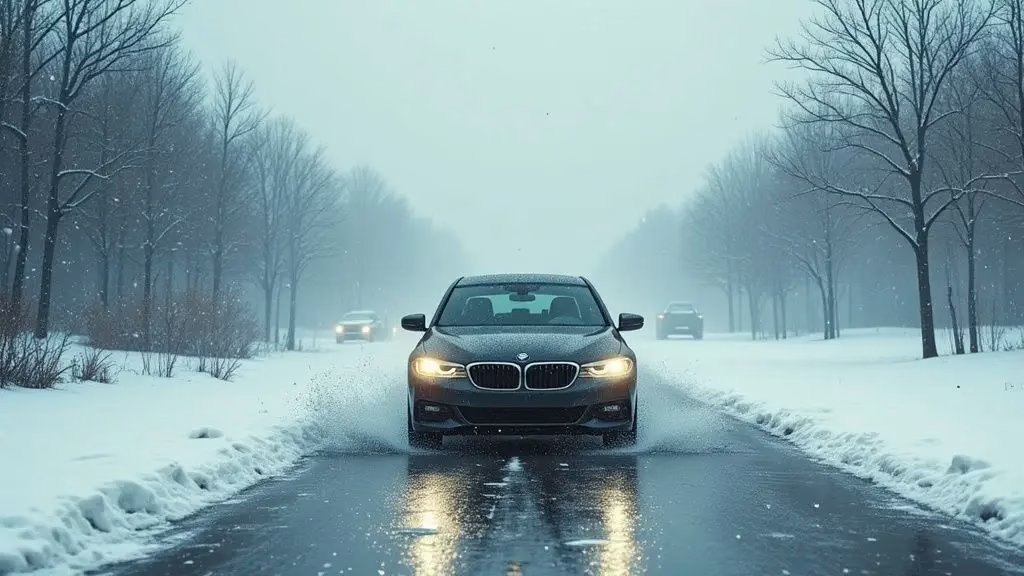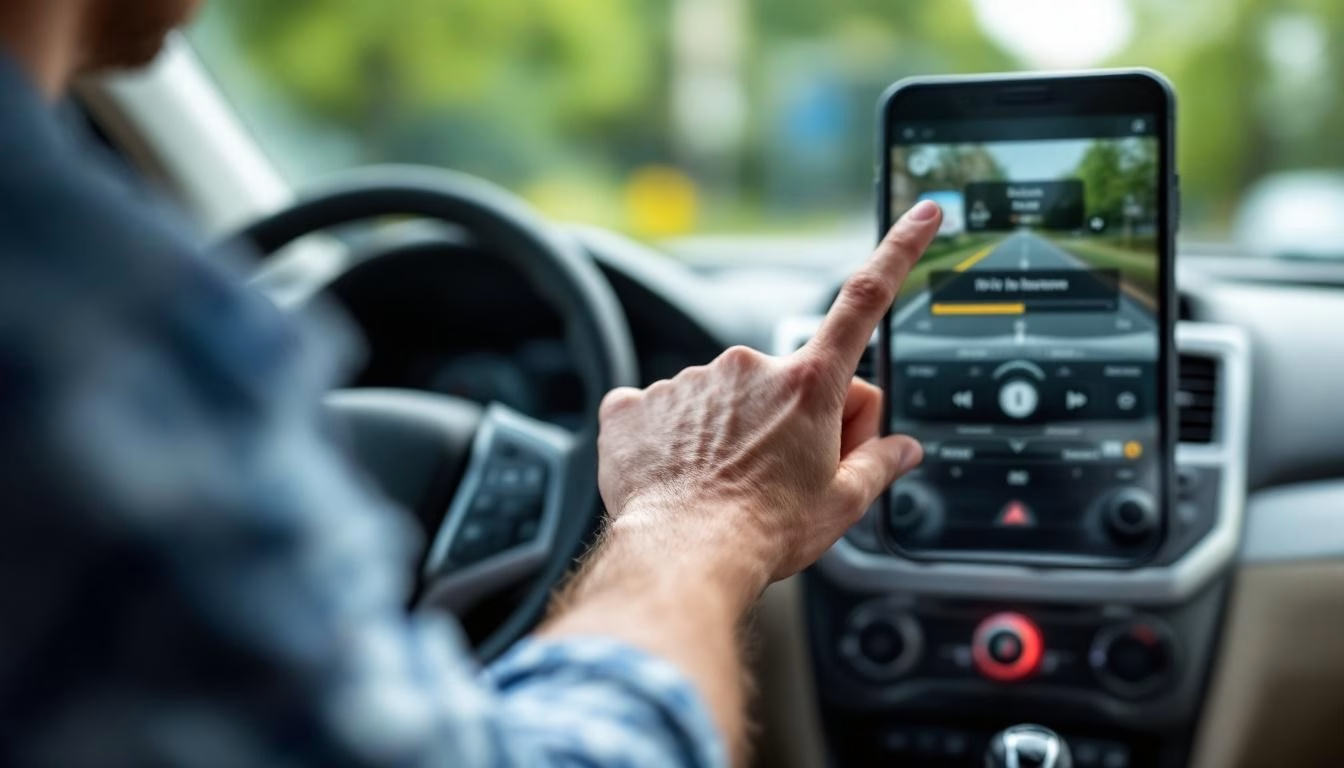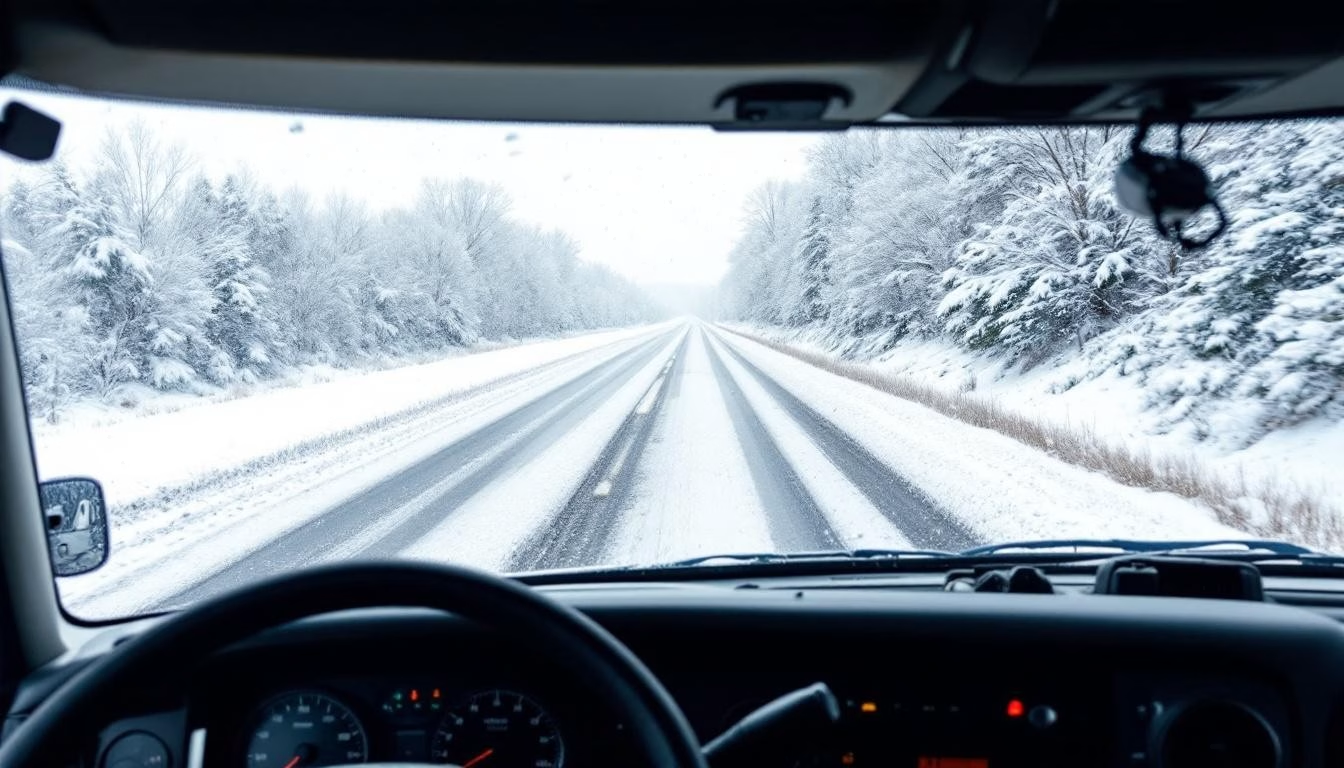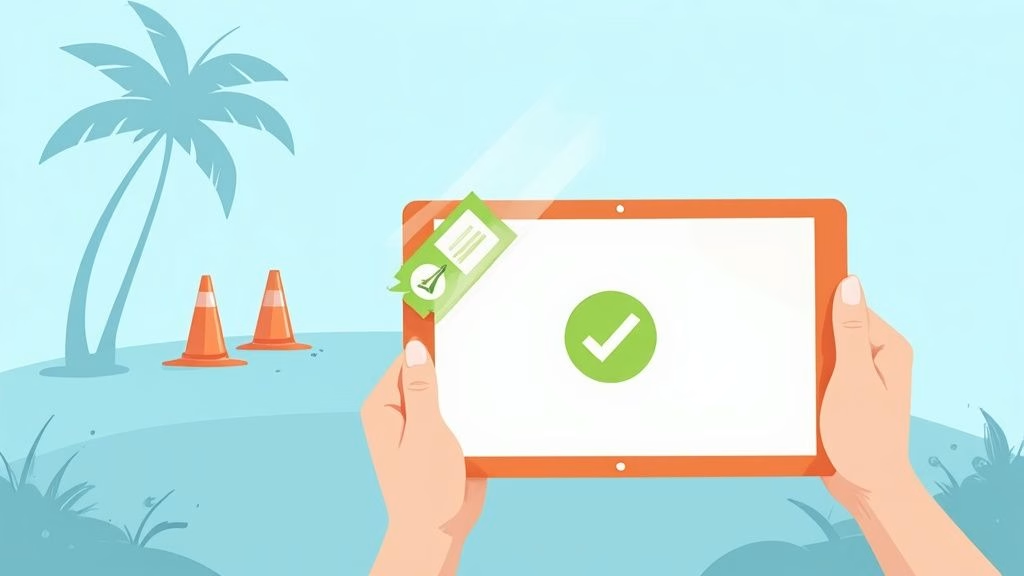Driving safely in bad weather isn�t just about what you do behind the wheel; it�s about having a proactive mindset. Your safety prep should start long before you even turn the key. The whole idea is to get your vehicle ready, know its features inside and out, and plan your trip to account for whatever Mother Nature throws at you.
This isn’t about panic; it’s about building confident control.
Building Your Foundation for All-Weather Driving
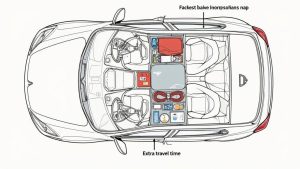
Getting ready for a drive in tough conditions is more than just running down a generic checklist. It’s about creating a personal system that works for you. The goal here is to cut down on stress so you can pour all your focus into the road when the weather turns nasty.
This approach is more important than ever. According to the World Health Organization, there are approximately 1.19 million road traffic deaths worldwide each year, and you can bet that poor weather plays a big part in those numbers.
Assemble a Practical Emergency Kit
Don’t just grab a pre-made kit from a big-box store and call it a day. Think about where you live and the roads you drive on most. A driver in sunny Florida has a completely different set of worries than someone navigating the mountains of Colorado.
- For Cold Climates: You’ll want a collapsible shovel, a good ice scraper, thermal blankets, and some high-energy snacks. A bag of cat litter or sand can also be a lifesaver for getting traction if you’re stuck on ice.
- For Warm Climates: Focus on packing extra water, a sunshade for your windshield, and maybe even a small portable fan. A reliable power bank is a must, as intense heat can kill your phone battery fast.
- Universal Essentials: No matter where you are, your kit should have jumper cables, a first-aid kit, a flashlight with fresh batteries, and reflective triangles or flares.
A well-stocked, climate-appropriate kit does more than prepare you for an emergency. It gives you peace of mind on every single trip, letting you concentrate on driving instead of worrying about what could happen.
Understand Your Vehicle’s Safety Systems
Modern cars are packed with technology designed to help you out in slick conditions, but they’re not miracle workers. You have to know what these systems do�and what they can’t do�to really benefit from them.
Anti-lock Braking System (ABS) is designed to keep your wheels from locking up during a hard stop, which lets you maintain steering control. If you ever feel the brake pedal vibrating or pulsing under your foot, that’s the ABS doing its job. The key is to not pump the brakes like in an older car. Just apply firm, steady pressure and let the system work.
Traction Control System (TCS) does its thing when you accelerate, limiting how much your wheels can spin. If you hit the gas too hard on a wet or icy road, TCS will cut engine power or tap the brakes to help the tires find their grip. Of course, basic features are just as vital�good visibility is non-negotiable. If your windows are acting up, look into fixing power window issues before you get caught in a downpour.
Adopt a Proactive Mindset
The final piece of the puzzle is all mental. It’s about switching from being a reactive driver to a defensive one. Before heading out, check the weather forecast for your entire route, not just your final destination.
Give yourself a serious time buffer. Plan for the trip to take at least 25-50% longer than it would on a clear day.
And one last thing: tell someone your plan. Let a friend or family member know where you’re going and when you expect to get there. These simple, proactive steps are the bedrock of safe driving. To build on this foundation, check out our guide on Defensive Driving techniques.
Taming Treacherous Roads: How to Handle Rain and Hydroplaning
Driving in the rain might feel like just another Tuesday, but don’t let the routine fool you. It’s one of the most consistently hazardous situations we face behind the wheel. The moment that first drizzle hits the pavement, it starts mixing with all the oil, grime, and dust that’s been baking on the road. The result? A surface that�s surprisingly slick, often when you least expect it.
That first ten minutes of a light shower can be the most dangerous. The rain hasn’t been falling long enough to wash the muck away, leaving behind a greasy film that dramatically cuts down on your tires’ ability to grip the road.
Give Yourself a Serious Safety Cushion
On a wet road, your stopping distance isn’t just a little longer�it can easily double or even triple compared to dry conditions. That old “two-second rule” you learned in driver’s ed? It�s completely out the window. You need to open up that gap to at least four or five seconds.
It�s easy to check. Just watch the car ahead of you pass a fixed point�a telephone pole, a sign, anything. Then start counting: “one-one-thousand, two-one-thousand…” and so on. If your front bumper reaches that same spot before you get to four, you are way too close. That extra space is your lifeline, giving you the critical time to react and brake smoothly instead of slamming on the pedal in a panic.
This isn’t just about being cautious; it’s about survival. CDC research has shown that as rain gets heavier, the risk of a fatal crash more than doubles. You’re fighting a battle on two fronts: visibility goes down, and the road surface becomes a slippery mess.
Adjusting Your Driving for Rain Intensity
Not all rain is created equal. A light mist requires a different approach than a torrential downpour. Here�s a quick guide to help you adapt your driving based on how hard it’s coming down.
| Rainfall Level | Recommended Speed Reduction | Minimum Following Distance |
|---|---|---|
| Light Drizzle | 5-10 mph below speed limit | 4-5 Seconds |
| Steady Rain | 10-15 mph below speed limit | 5-6 Seconds |
| Heavy Downpour | 15-25 mph below speed limit | 6+ Seconds (or pull over) |
Remember, these are just starting points. If visibility is severely limited or you see standing water, slow down even more. The goal is to stay in control, not to get there fast.
The Real Danger: Hydroplaning
Ever had that terrifying feeling where the car suddenly feels like it’s floating? That’s hydroplaning. It happens when a wedge of water builds up between your tires and the road, lifting your car right off the pavement. Your steering wheel goes light, your brakes do nothing, and for a moment, you’re just a passenger.
It can happen faster than you think, at speeds as low as 35 mph if there’s enough water on the road or if your tires are worn. Keeping your tires properly inflated and with good tread is your best defense, but even brand-new tires can’t overcome the laws of physics if you’re going too fast into deep water.
Expert Tip: If you feel the car start to hydroplane, your gut reaction will be to stomp on the brake. Fight that instinct. It�s the single worst thing you can do. Hitting the brakes can lock your wheels, and when your tires finally do regain contact with the road, you�ll be thrown into an uncontrollable skid.
Instead, here�s what experienced drivers do:
- Go easy on the pedals. The very first thing to do is smoothly take your foot off the accelerator. No sudden moves. Don’t even think about the brake.
- Look and steer where you want to go. Keep your hands steady on the wheel and your eyes pointed down the road. If the car starts to drift, make only small, gentle steering corrections to keep it straight.
- Let the car slow itself down. Be patient and let the car’s drag naturally slow you down. You’ll feel a slight jolt as the tires bite into the pavement again.
- Gently test your control. Once you feel you have traction back, you can carefully apply the brakes or accelerate if you need to.
Mastering wet conditions is all about being proactive. Slow down before you hit the standing water and stay alert. For more on this, check out these other essential driving in rain safety tips.
Conquering Winter Roads: Snow and Ice
Let’s be clear: winter driving is a whole different ball game. It’s not just about taking it slow. It’s about developing a sixth sense for the road, anticipating hazards you can’t even see, and making every move�steering, braking, accelerating�incredibly smooth and deliberate. The single most important tool in your arsenal is a healthy respect for the conditions.
The statistics on this are sobering. Freezing precipitation is a major killer on the roads, contributing to an estimated 574,047 crashes annually. Those crashes lead to 2,810 deaths, which accounts for a staggering 74 percent of all weather-related driving fatalities.
The Invisible Threat of Black Ice
Of all the winter hazards, black ice is the most treacherous because you often don’t see it until you’re on top of it. It looks like a simple wet patch on the pavement, but it�s a thin, nearly invisible sheet of ice.
You’ll find it lurking on bridges, overpasses, and in shady spots where the road surface never gets a chance to warm up. Keep an eye out for a glossy, dark sheen on the road ahead, especially when other areas look dry. Another dead giveaway? If you see cars up ahead suddenly wiggle or swerve for no obvious reason, they’ve likely hit a patch.
Hitting black ice triggers a primal urge to slam on the brakes. You have to fight that instinct. Just like with hydroplaning, the move is to do as little as possible. Take your foot off the accelerator, keep the wheel pointed straight, and avoid any sudden inputs. Your goal is to simply glide over the patch until your tires find grip again on the other side.
Mastering Skid Control
No matter how careful you are, skids can happen. Knowing how to react based on which wheels have lost traction is what separates a close call from a crash.
- Understeer (Front-Wheel Skid): You turn the wheel, but the car just wants to plow straight ahead. This is classic in front-wheel-drive vehicles. The fix is to ease off the gas and, counterintuitively, reduce your steering angle slightly. This allows the front tires to regain traction.
- Oversteer (Rear-Wheel Skid): This is the classic “fishtail,” where the back end of your car starts to slide out. To correct it, you have to steer into the skid. Look where you want to go and smoothly turn the wheel in that same direction.
Getting familiar with local advice can also be a lifesaver, as conditions vary so much by region. For example, drivers in the Rockies face unique challenges, and it’s worth reviewing specific guides like these Colorado winter driving safety guidelines.
Get Your Vehicle Ready Before the First Flake
Your skill behind the wheel is only half the equation. Your car has to be ready to perform in the cold. A pre-winter check-up isn’t just a good idea; it’s essential.
Pay special attention to your tires�they are your only connection to the road. All-season tires might get you by in an occasional light dusting, but if you live anywhere that gets real snow and ice, dedicated winter tires are the single best safety investment you can make. They use a softer rubber compound and have special tread patterns designed to bite into snow and ice, offering a world of difference in grip.
The infographic below shows a simple recovery process for when you lose traction, which is a core skill for any kind of slippery condition.
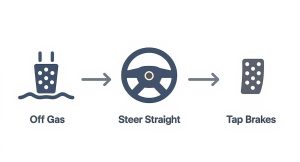
Remember, your first reaction�getting your feet off the pedals�is almost always the most important step toward getting the car back under your control.
Driving Safely Through Fog and Darkness
When visibility plummets, your entire approach to driving needs to shift. Fog and darkness can be incredibly disorienting, making a road you drive every day feel completely unfamiliar.
The most critical rule is one I�ve seen ignored far too often: never outrun your headlights. Simply put, you must be able to stop your car completely within the patch of road illuminated in front of you.
Driving too fast for what you can see is a recipe for disaster. Think about it: at 60 mph, your car travels the length of a football field in just a few seconds. Your headlights only light up a small piece of that distance, leaving you no time to react if a stalled car, an animal, or debris suddenly appears.
Mastering Your Lights for Maximum Visibility
Using your lights correctly is about more than just flipping a switch; the wrong setting can make a dangerous situation even worse. Fog, especially, requires a specific game plan.
So many drivers make the classic mistake of turning on their high beams in dense fog. This is one of the worst things you can do. The intense light just reflects off the millions of tiny water droplets in the air, creating a blinding white wall that makes it impossible to see.
- Low Beams: This is your go-to setting for fog and heavy rain. The beams are aimed downward, lighting up the road surface under the fog and cutting down on that reflective glare.
- Fog Lights: If your car has them, use them. They�re mounted low for a reason�to send a wide beam of light under the fog, illuminating the lane markings and the edge of the road right in front of you.
- High Beams: Save these for clear nights on empty, unlit roads. The second you see another car’s headlights or taillights, you need to switch them off immediately to avoid blinding the other driver.
Navigating When You Can Barely See
When visibility is near zero, you have to use the road itself to find your way.
Focus on the solid white line on the right side of the road�often called the “fog line.” This should be your main guide. It gives you a reliable reference for your position without pulling your focus toward oncoming traffic. Many drivers instinctively watch the center line, which can cause them to drift dangerously to the left.
When the world outside your windshield disappears, that painted line at the edge of the road is your lifeline. Trust it. Trust the little reflectors on the pavement. They are designed to be seen when nothing else is.
Keep an eye out for those reflective markers on the road surface and on posts; they are designed to catch your headlights and show you where the road is heading. Just as importantly, you need to add a huge amount of space between you and the car ahead. If you can barely make out their taillights, you are way too close.
At night, the glare from other cars is another major hazard. The key is to avoid staring directly into the headlights of an oncoming vehicle. Instead, briefly shift your gaze down and to the right, using the edge of the road as your guide until the car passes. A clean windshield�inside and out�also makes a huge difference in reducing glare. For more on this, check out our guide with more night driving tips.
Handling High Winds, Dust Storms, and Extreme Heat
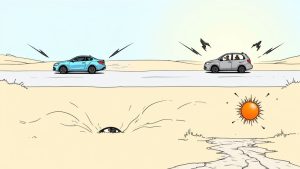
When we think of dangerous driving, we usually picture slick winter roads or torrential downpours. But blistering heat, sudden dust storms, and powerful crosswinds bring their own unique set of challenges that can catch even experienced drivers off guard.
Strong winds, in particular, are deceptive. A sudden gust can hit with enough force to feel like another car has slammed into your side, shoving you across the lane line in a heartbeat. This is especially true for high-profile vehicles like SUVs, vans, and trucks, which essentially act like a sail.
When you’re driving in windy conditions, keep a firm, two-handed grip on the wheel. Be ready for those gusts when you�re crossing bridges, coming out from behind a large truck, or driving through mountain passes. If a big gust hits, your instinct might be to yank the wheel, but a smooth, steady correction is the key to staying in control.
Reacting to Sudden Visibility Loss
Imagine this: you’re cruising down the highway on a clear day, and in the distance, you see what looks like a low-hanging cloud on the horizon. Within seconds, it’s upon you�a blinding wall of dust that drops visibility to practically zero.
This terrifying scenario is a reality in many parts of the country. When it happens, the only safe response is the “Pull Aside, Stay Inside” protocol.
- Slow Down Immediately: Take your foot off the accelerator, but avoid slamming on the brakes.
- Pull Off the Road: Signal and pull your vehicle as far off the pavement as you possibly can. Don’t just stop in your lane.
- Turn Off All Lights: This is the most crucial and counterintuitive step. Turn off your headlights, taillights, and even your hazard lights. Why? A disoriented driver behind you might see your lights and try to follow them, thinking you’re still moving on the road. This is how multi-car pileups happen.
- Stay Put: Engage the parking brake, keep your seatbelt fastened, and wait for the storm to blow over.
The most dangerous thing you can do in a dust storm or a whiteout is to keep driving, even slowly. By pulling completely off the road and turning off your lights, you remove yourself from the chain reaction of potential collisions. Your car is a metal box designed to protect you�stay in it.
Defending Against Extreme Heat
Intense summer heat wages a silent war on your car. The most immediate threat is a tire blowout. Hot asphalt dramatically increases the air pressure in your tires, and if a tire is even slightly underinflated, it will flex more, generating even more internal heat. It�s a recipe for disaster. Always check your tire pressure before a long trip in the heat.
Your engine is also working overtime. If you see that temperature gauge start creeping toward the red, you need to act fast. First, turn off the A/C, which puts a heavy load on the engine. Then, turn your heater on full blast. It sounds miserable, but it pulls excess heat away from the engine block and into the cabin.
If that doesn’t bring the temperature down, find a safe place to pull over, shut the engine off, and let it cool down completely. Mastering these techniques is a critical part of comprehensive driver safety. For more region-specific advice, you can explore resources covering driving safety during severe weather in Florida.
Adverse Condition Response Checklist
Sudden weather events demand quick, correct reactions. Here�s a quick-reference table to summarize the immediate actions you should take.
| Condition | Immediate Action | Key Precaution |
|---|---|---|
| Dust Storm | Pull as far off the road as possible, turn off all lights, set parking brake. | Stay inside your vehicle with your seatbelt on. |
| Strong Crosswind | Reduce speed, maintain a firm two-handed grip on the wheel. | Be extra cautious on bridges, overpasses, and open plains. |
| Engine Overheating | Turn off A/C, turn on heater full blast. If it continues, pull over safely. | Never open a hot radiator cap. |
| Hydroplaning | Ease off the accelerator, steer gently in the direction you want to go. | Avoid sudden braking or turning. |
Memorizing these responses can make the difference between a close call and a serious accident. The key is to stay calm, react deliberately, and prioritize getting yourself and your vehicle out of harm’s way.
Answering Your Top Bad-Weather Driving Questions
Let’s be honest, driving when the weather turns nasty can be nerve-wracking. Even if you’ve been behind the wheel for decades, a sudden downpour or an unexpected patch of ice can get your heart pounding.
Here are some answers to the questions I hear most often. Think of this as a quick-reference guide to help you cut through the confusion and react with confidence instead of panic.
Does All-Wheel Drive Make My Car Unstoppable on Ice?
This is a big one. It’s so easy to believe that an all-wheel drive (AWD) or four-wheel drive (4WD) system makes you immune to winter’s worst. While these systems are genuinely great for getting you going from a standstill in deep snow, they provide almost no extra help when you need to stop or turn on ice.
Here�s the reality: your ability to stop and steer comes down to one thing�the grip between your tires and the road. AWD is all about sending power to the wheels for acceleration, but it can’t magically create traction that isn’t there.
I’ll put it this way: a simple front-wheel-drive car with good winter tires will run circles around an AWD SUV on all-season tires when it comes to stopping and cornering on ice. Don’t let that AWD badge give you a false sense of security. Everyone’s braking distance is dangerously long on ice, so slow down.
What Should I Actually Do If My Car Starts to Skid?
When your car starts sliding, your first instinct is probably to slam on the brakes and wrench the steering wheel. You have to fight that impulse with everything you’ve got. The right move depends entirely on which end of the car is losing its grip.
- Front-Wheel Skid (Understeer): This is when you turn the wheel, but the car just wants to plow straight ahead. The fix? Gently ease your foot off the gas and dial back your steering input a little. This gives the front tires a chance to find traction again.
- Rear-Wheel Skid (Oversteer): You’ll feel this when the back of your car starts to swing out. The key is to immediately look where you want to go�not at what you’re about to hit�and smoothly steer in that direction. We call this “steering into the skid.”
No matter which type of skid you’re in, your first move should always be to take your feet off both the gas and the brake. Letting the wheels roll freely is the first step to regaining control.
Is It Okay to Drive With My Hazard Lights on in the Rain?
I see this all the time, but it’s a really contentious issue and can even be illegal depending on where you live. As a general rule of thumb, you should not drive with your hazard lights on.
Emergency flashers are designed for one purpose: to signal that your vehicle is stopped and disabled. Using them while you’re moving just creates confusion. Other drivers can’t tell if you’re braking or about to turn, because the flashers usually override your brake lights and turn signals. The safer, clearer choice is to simply turn on your headlights to make sure you’re visible.
Driving safely isn’t a one-and-done lesson; it�s a skill you build over time. For drivers in Florida looking to brush up on their skills, take care of a traffic ticket, or even lower their insurance premium, BDISchool provides a state-approved online course that fits your schedule. You can enroll today at https://bdischool.com and get on the road to becoming a more prepared, confident driver.

